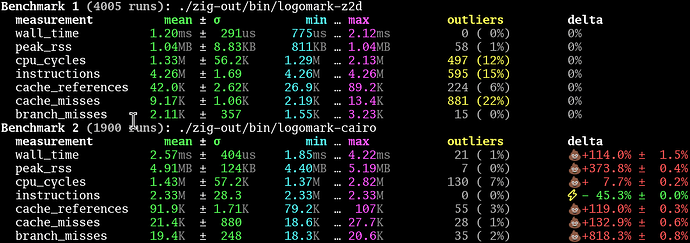Hey folks! I thought I’d post on Ziggit about z2d, my pure Zig 2D graphics library.
I have been working on this library now for a little over a year (you may have seen me posting progress about it if you are on the Zig or Ghostty Discords!). While there’s always more to do, I’d like to think that over the last few months it’s gotten more and more feature complete.
So what can z2d do currently?
- Vector primitives: lines, splines, and arcs (arc helper approximates using splines).
- Fill and stroke with support for different stroke join styles, cap styles, and dashed lines.
- Transformations of various kinds for a number of operations in the library.
- Sources include pixel and gradient patterns (linear, radial, and conic).
- Composition: 28 different Porter-Duff and blend mode operators using a multi-step compositor.
- Surface formats: RGB/RGBA, and 8/4/1-bit alpha.
- Color space support: RGB, sRGB (simple gamma transfer at the moment) and HSL supported currently (polar interpolation in HSL is supported for gradients as well). More spaces are planned.
There are also other features, like a toy PNG exporter for testing, and dithering support, useful for reducing banding in gradients.
Finally, I should note that z2d is currently CPU rendering only and there is not a current roadmap for GPU support. This is not to say it won’t be done, just that there are still other things that I want to do before moving on to this.
I work on z2d regularly and am nowhere close to done. More of the current features will be improved on over the next few months, and text support is planned as well. Check it out and let me know if you have any feedback, questions, or if you’ve found it useful!


